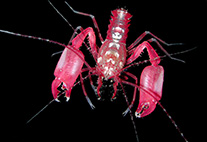Abstract
Tripylina puxianensis n. sp. is described and illustrated from Shanxi province, China. It is characterized by having a triangular dorsal tooth, pointing towards the ventral side, anterior to two sub-ventral teeth, with dorsal and sub-ventral teeth similar in shape and size; one ventromedian seta in the cervical region; vulva with protruding lips, absence of post-uterine sac; and a pair of setae on the tail; male not found; female body length 1048–1331 μm, a = 25.5–33.8, b = 5.5–6.2, c = 14.4–23.1, c' = 2.1–3.5 and V = 56.1–68.5%. The phylogenetic relationships among species in the genus Tripylina were analyzed using data from the SSU (small subunit) and D2/D3 expansion segments of the LSU (large subunit) rDNA. These analyses confirmed that T. puxianensis n. sp. is different from other members of the genus for which sequences are available.
References
Andrássy, I. (2007) Free-living nematodes of Hungary, II (Nematoda errantia). In Pedozoologica Hungarica, No. 4, eds C. Csuzdi & S. Mahunka, Hungarian Natural History Museum and Systematic Zoology Research Group of the Hungarian Academy of Sciences, Budapest, Hungary, 496 pp.
Andrássy, I. (2008) Two new and a known species of the family Tripylidae (Nematoda: Enoplida) from the tropics. Opuscula Zoologica Budapestinensis, 37, 3–9.
Argo, A.D. & Heyns, J. (1973) New and little known species of the nematode families Monhysteridae and Tripylidae from South Africa. Phytophylactica, 5, 149–154.
Asghari, R., Pourjam, E., Heydari, R., Zhao, Z.Q. & Ramaji, F.A. (2012) Tripylina gorganensis n. sp. (Triplonchida: Tripylidae) from northern Iran. Nematology, 14, 613–621.
http://dx.doi.org/10.1163/156854112x624609Brzeski, M.W. & Winiszewska-Ślipińska, G. (1993) Taxonomy of Tripylidae (Nematoda: Enoplia). Nematologica, 39, 12–52.
http://dx.doi.org/10.1163/187529293X00024Brzeski, M.W. (1963) Nematode genera of the family Tripylidae (Nematoda, Enoplida). Acta Zoologica Cracoviensia, 8, 295–308.
Cid del Prado-Vera, I., Ferris, H. & Nadler, S.A. (2010) Soil inhabiting nematodes of the genera Trischistoma, Tripylina and Tripyla from Mexico and the USA with descriptions of new species. Journal of Nematode Morphology and Systematics, 13, 29–49.
Cid del Prado-Vera, I., Ferris, H., Nadler, S.A. & Lamothe-Argumedo, R. (2012) Four new species of Tripylina Brzeski, 1963 (Enoplida: Tripylidae) from México, with an emended diagnosis of the genus. Journal of Nematode Morphology and Systematics, 15, 71–86.
De Ley, I.T., De Ley, P., Vierstraete, A., Karssen, G., Moens, M. & Vanfleteren, J. (2002) Phylogenetic analysis of Meloidogyne small subunit rDNA. Journal of Nematology, 34, 319–327.
De Ley, P. & Blaxter, M. (2004) A new system for Nematoda: combining morphological characters with molecular trees, and translating clades into ranks and taxa. In Proceedings of the Fourth International Congress of Nematology, 8–13 June 2002, Tenerife, Spain. Nematology Monographs and Perspectives 2, eds R. Cook & D.J. Hunt, Brill, Leiden, The Netherlands, pp. 633–653.
De Man, J.G. (1880) Die einheimischen, frei in der reinen Erde und im süssen Wasser lebende Nematoden, monographisch bearbeitet. Vorläufiger Bericht und descriptiv- systematischer Theil. Tijdschrift der Nederlandsche Dierkundige Vereeniging, 5, 1–104.
Dorris, M., Viney, M.E. & Blaxter, M.L. (2002) Molecular phylogenetic analysis of the genus Strongyloides and related nematodes. International Journal of Parasitology, 32, 1507–1517.
http://dx.doi.org/10.1016/S0020-7519(02)00156-XLarget, B. & Simon, D.L. (1999) Markov chain Monte Carlo algorithms for the Bayesian analysis of phylogenetic trees. Molecular Biology and Evolution, 16, 750–759.
http://dx.doi.org/10.1093/oxfordjournals.molbev.a026160Moslehi, S., Niknam, G., Pedram, M., Zahedi, E. & Jabbari, H. (2010) Some free living nematodes from East Azarbaijan and Golestan provinces. Iranian Journal of Plant Pathology, 46, 71–80.
Nunn, G.B. (1992) Nematode Molecular Evolution. Ph.D. thesis. University of Nottingham, U.K.
Posada, D. & Crandall, K.A. (1998) Modeltest: testing the model of DNA substitution. Bioinformatics, 14, 817–818.
http://dx.doi.org/10.1093/bioinformatics/14.9.817Ronquist, F. & Huelsenbeck, J.P. (2003) MR BAYES: Bayesian inference of phylogenetic trees. Bioinformatics, 19, 1572–1574.
Seinhorst, W. (1959) A rapid method for the transfer of nematodes from fixative to anhydrous glycerine. Nematologica, 4, 67–69.
http://dx.doi.org/10.1163/187529259X00381Swofford, D.L. (1998) PAUP*. Phylogenetic Analysis Using Parsimony (*and Other Methods), Version 4. Sunderland, MA, USA, Sinauer Associates.
Tahseen, Q. & Nusrat, T. (2010) Some new and known species of genera Tripylina Brzeski and Trischistoma Cobb, 1913 (Nematoda) with a discussion on their relationships. Journal of Nematology, 42, 128–138.
Thompson, J.D., Higgins, D.G. & Gibson, T.J. (1994) CLUSTAL W: improving the sensitivity of progressive multiple sequence alignments through sequence weighting, position specific gap penalties and weight matrix choice. Nucleic Acids Research, 22, 4673–4680.
http://dx.doi.org/10.1093/nar/22.22.4673Tsalolikhin, S.J. (1983) Nematodes of the families Tobrilidae and Tripylidae of the World Fauna. Leningrad, Russia, Nauka, 232 pp. (in Russian)
Vinciguerra, M.T. & La Fauci, G. (1978) Nematodi muscicoli dell' isola di Lampedusa. Animalia, 5, 13–37.
Whitehead, A.G. and Hemming, J.R. (1965) A comparison of some quantitative methods for extracting small vermiform nematodes from soil. Annals of Applied Biology, 55, 25–38.
http://dx.doi.org/10.1111/j.1744-7348.1965.tb07864.xWilliams, B.D., Schrank, B., Huynh, C., Shownkeen, R. & Waterston, R.H. (1992) A genetic mapping system in Caenorhabditis elegans based on polymorphic sequence-tagged sites. Genetics, 131, 609–624.
Yeates, G.W. (1972) Trischistoma stramenti n. sp. (Nematoda: Enoplida) from leaf litter. New Zealand Journal of Science, 14, 578–900.
Zhao, Z.Q. (2009) A review of the genus Tripylina Brzeski, 1963 (Nematoda: Triplonchida), with descriptions of five new species from New Zealand. Zootaxa, 2238, 1–24.
Zhao, Z.Q. (2011) A review of Trischistoma Cobb, 1913 (Nematoda: Enoplida), with descriptions of four new species from New Zealand. Zootaxa, 3045, 1–25.
Zheng, J.W., Subbotin, S.A., He, S.S., Gu, J.F. & Moens, M. (2002) Molecular characterisation of some Asian isolates of Bursaphenlenchus xylophilus and B. mucronatus using PCR-RFLPs and sequences of ribosomal DNA. Russian Journal of Nematology, 11, 17–22.
Zullini, A. (2006) Order Triplonchida. In Freshwater nematodes: ecology and taxonomy, eds A. Eyualem, I. Andrássy & W. Traunspurger, CABI Publishing, Wallingford, UK, pp. 293–325.

